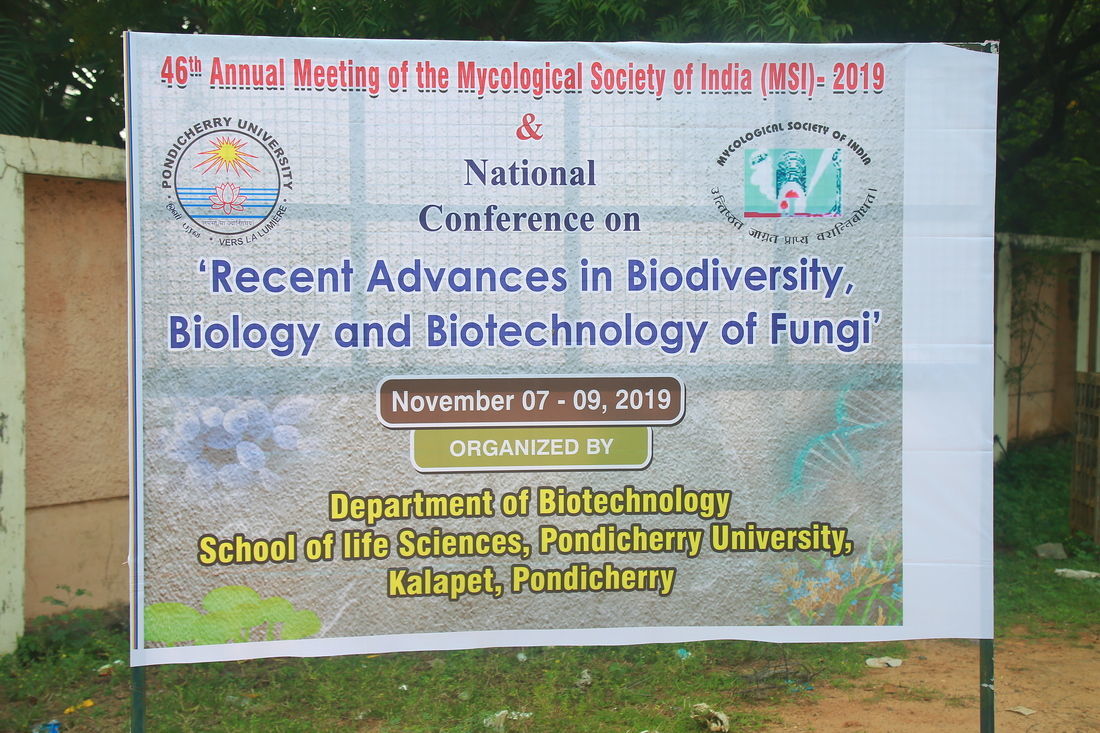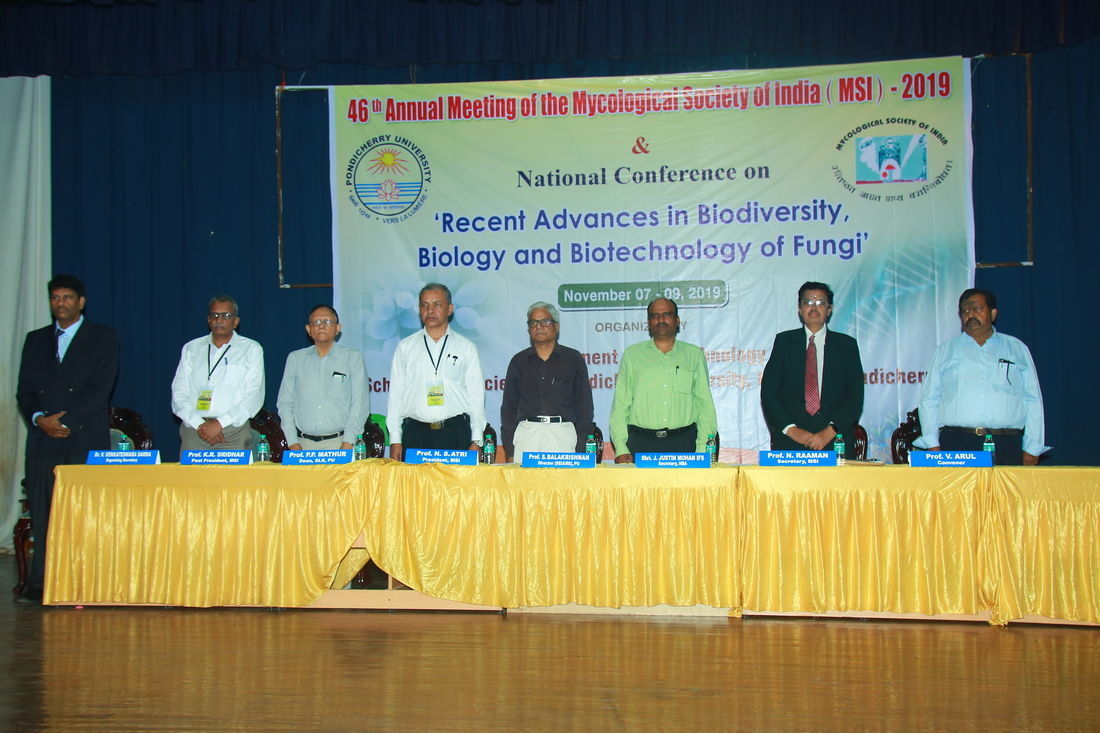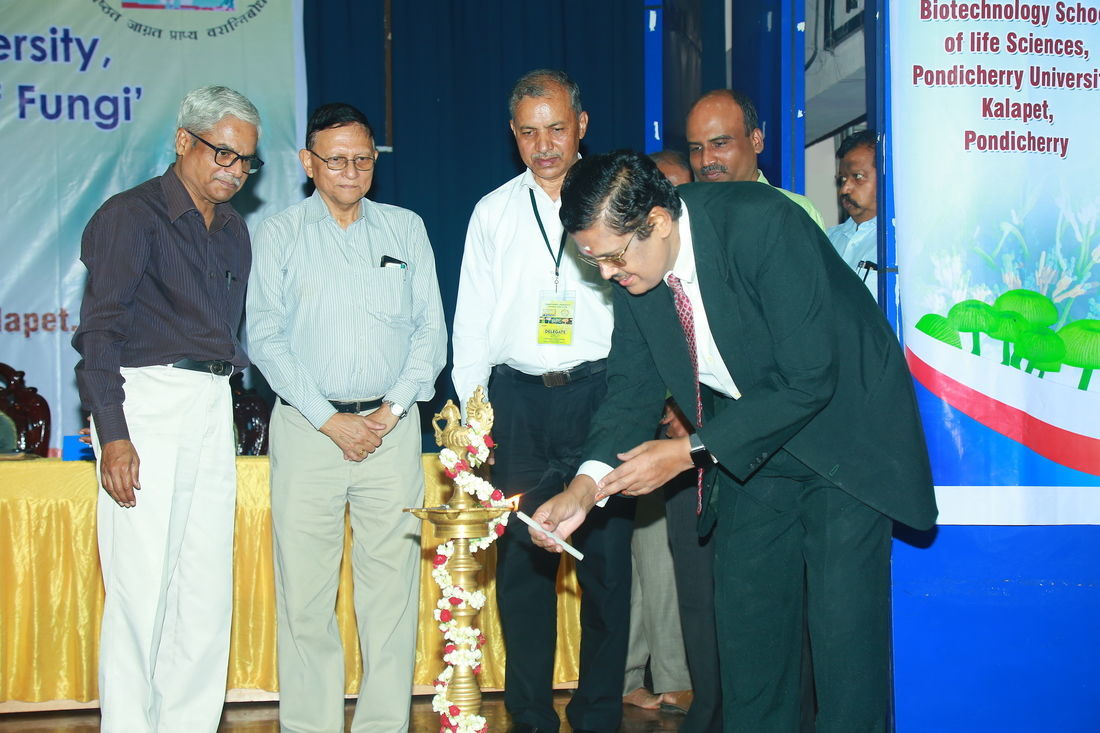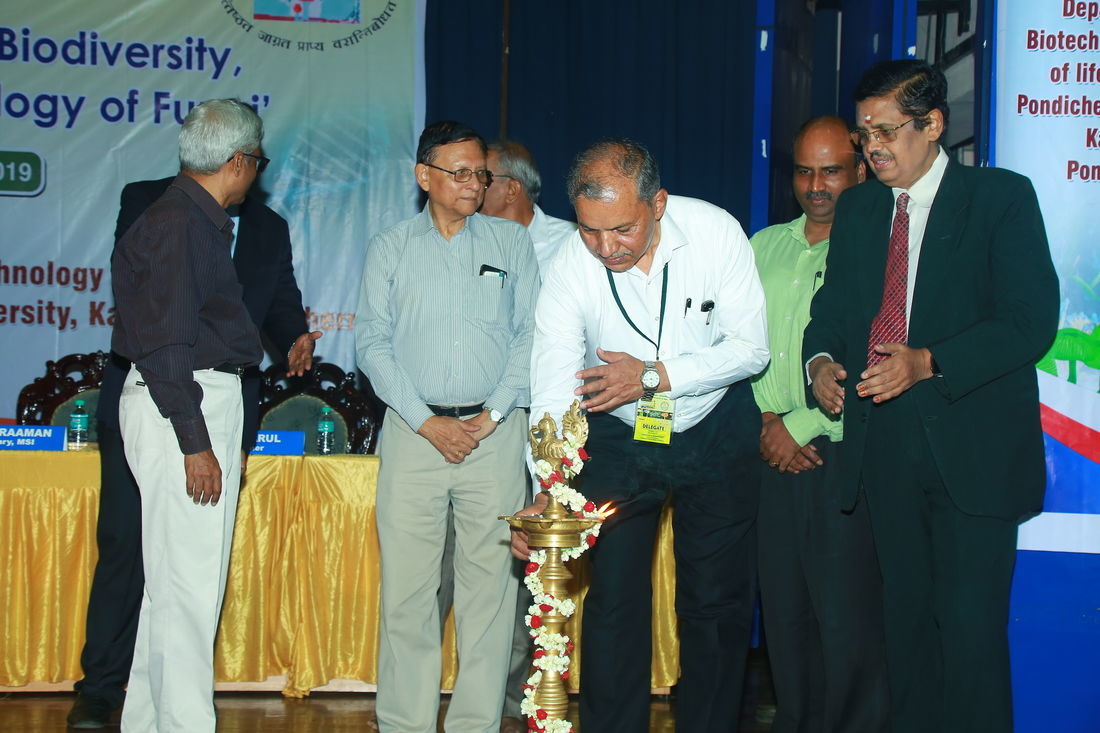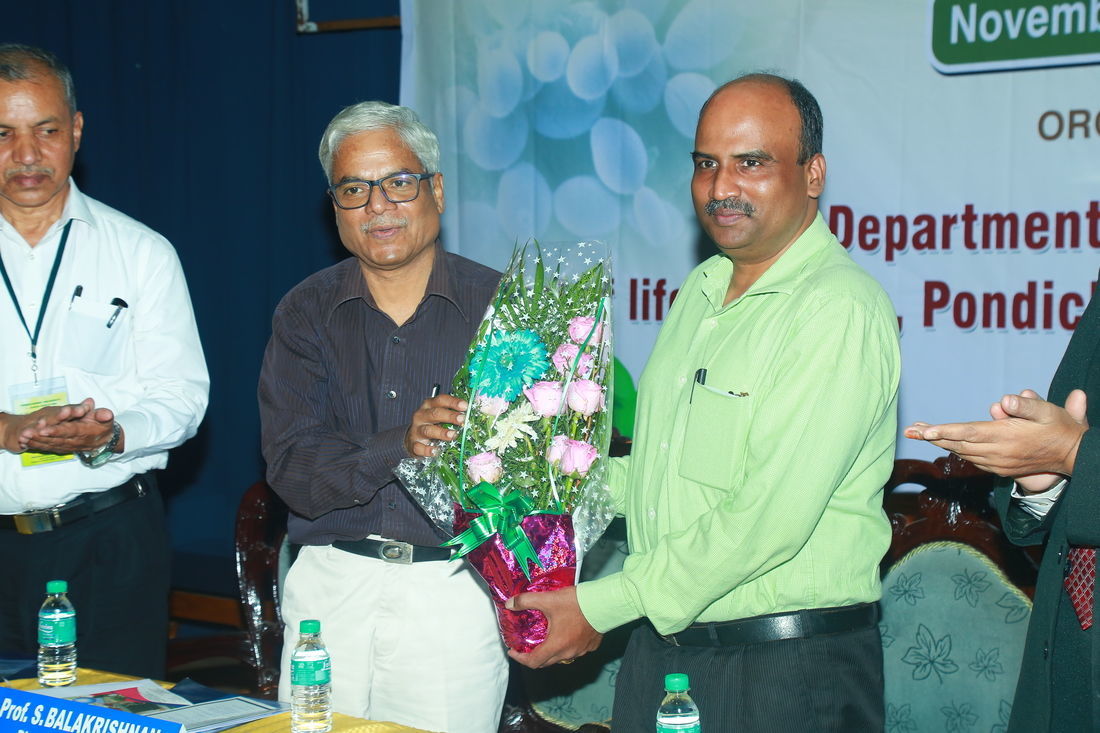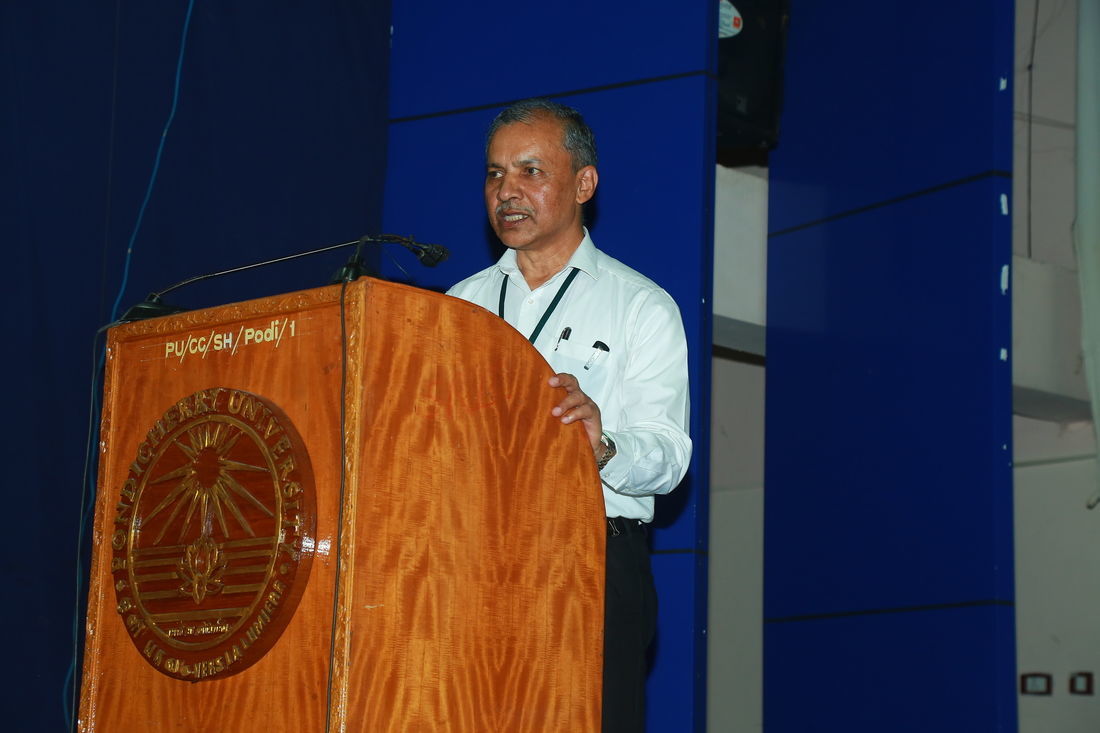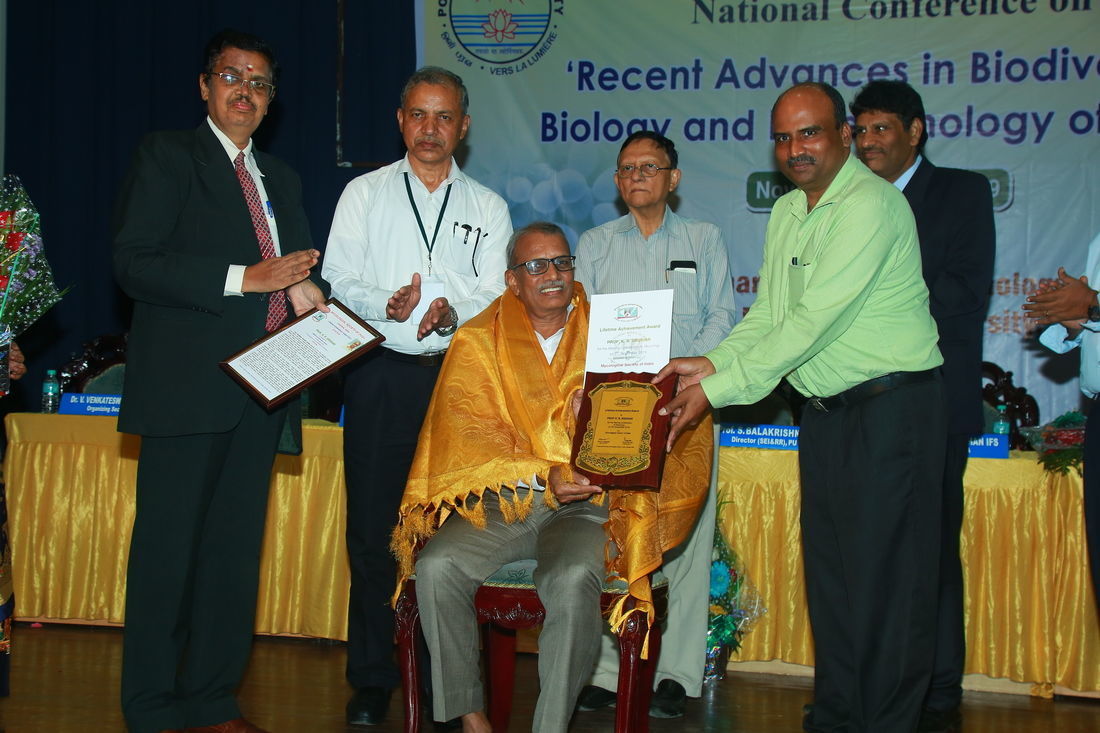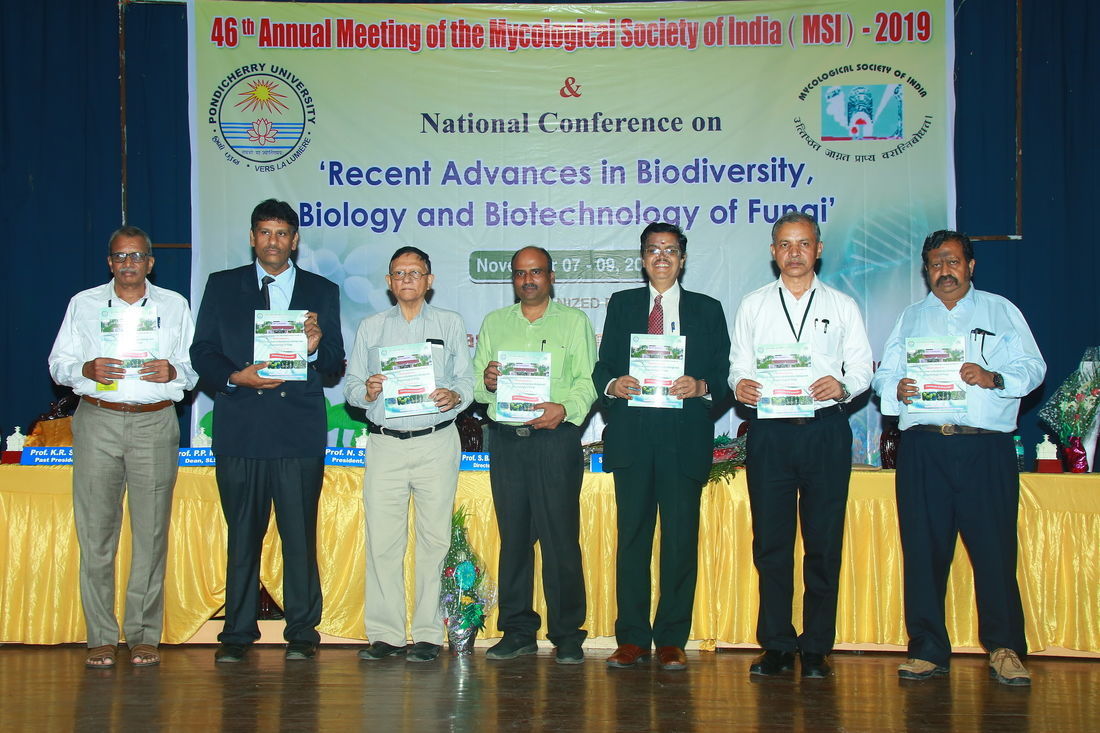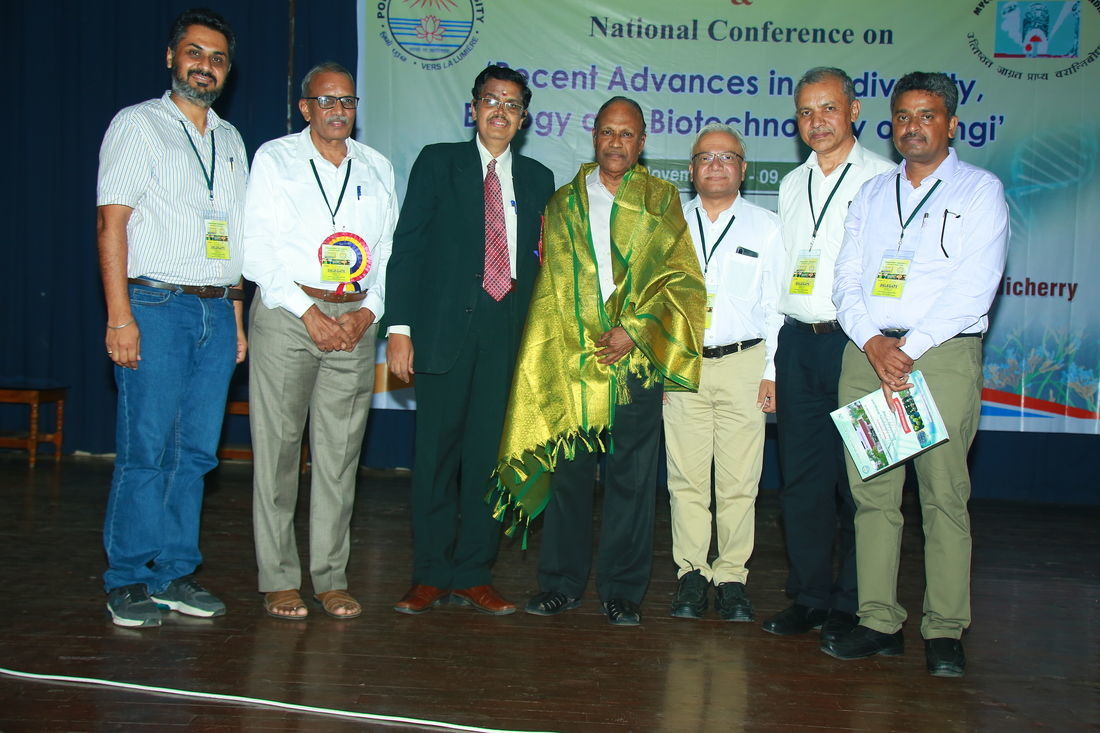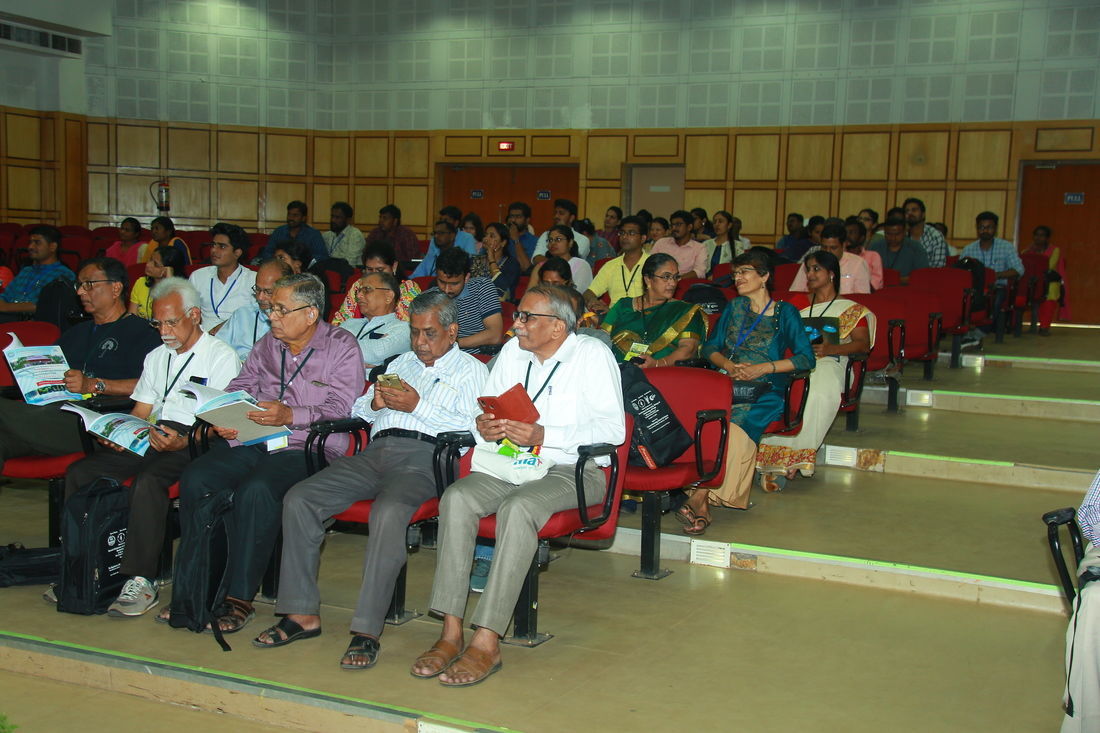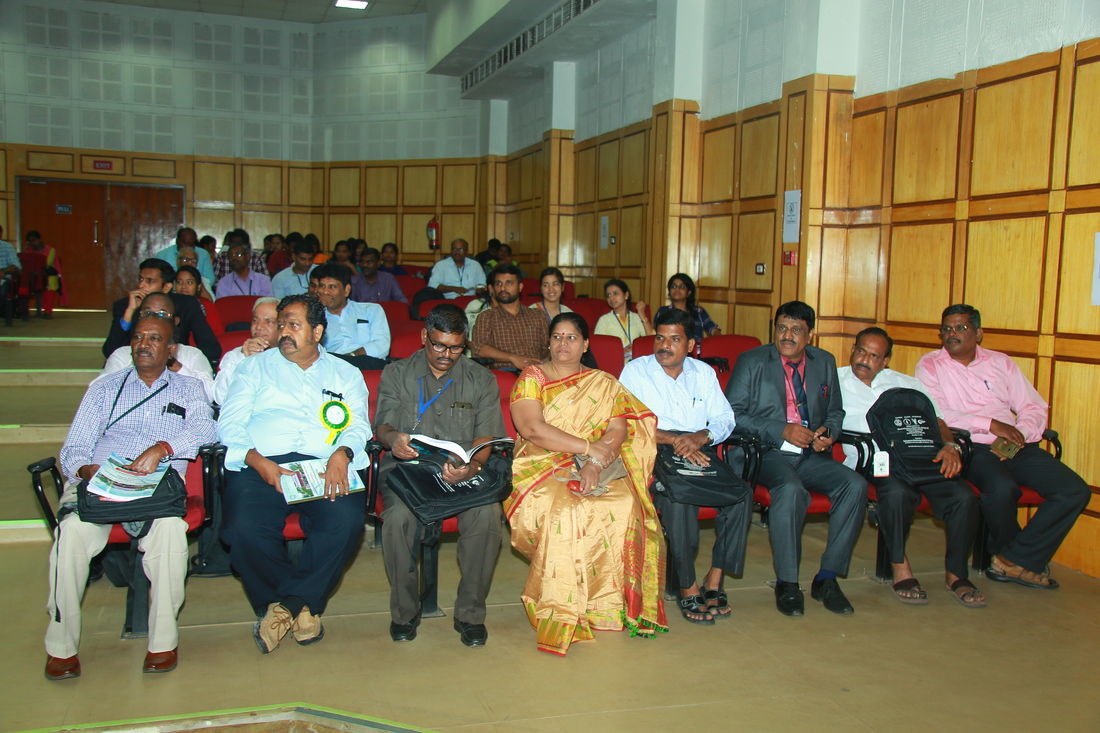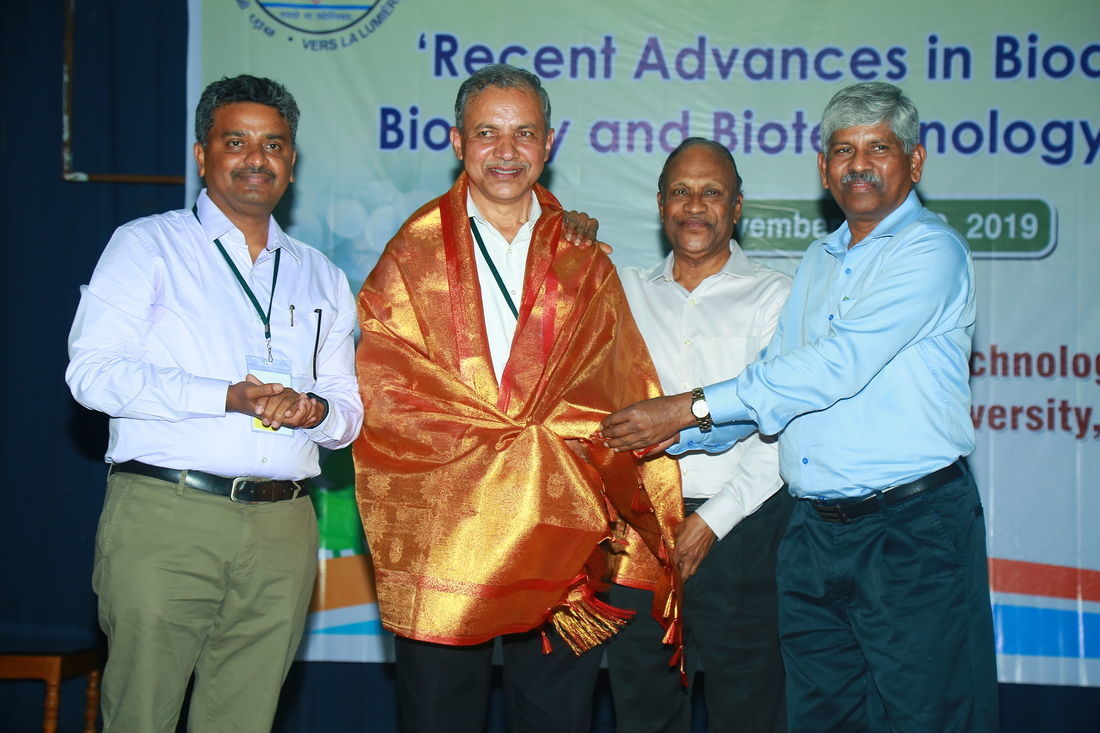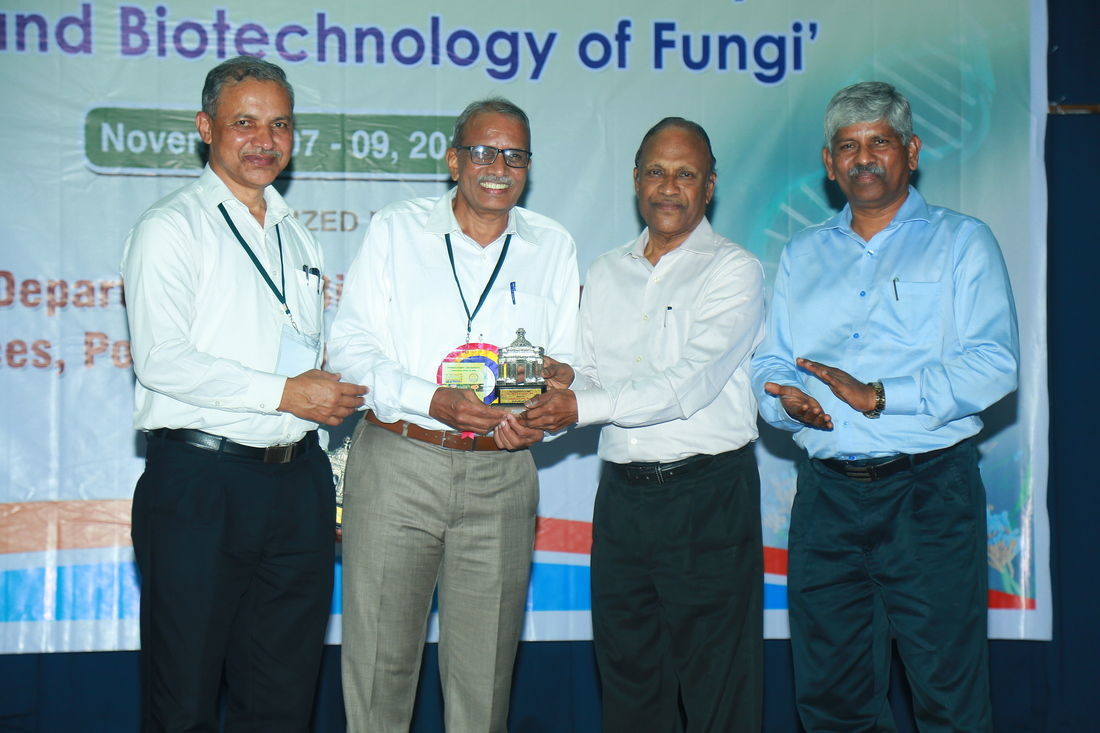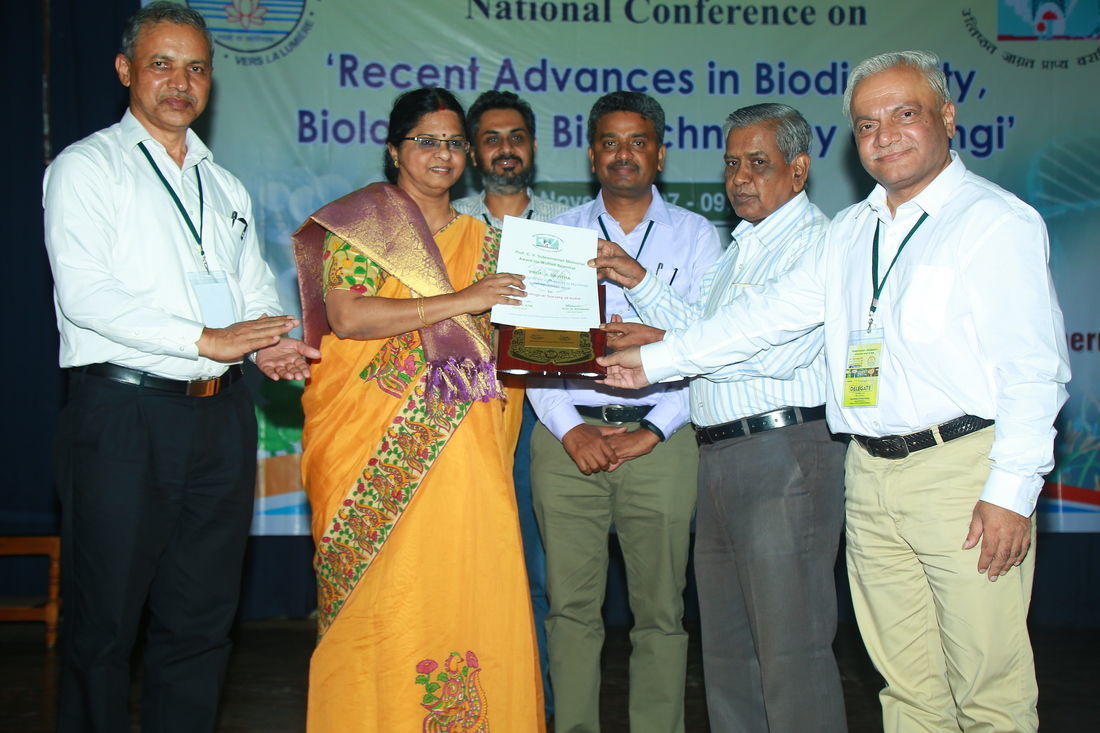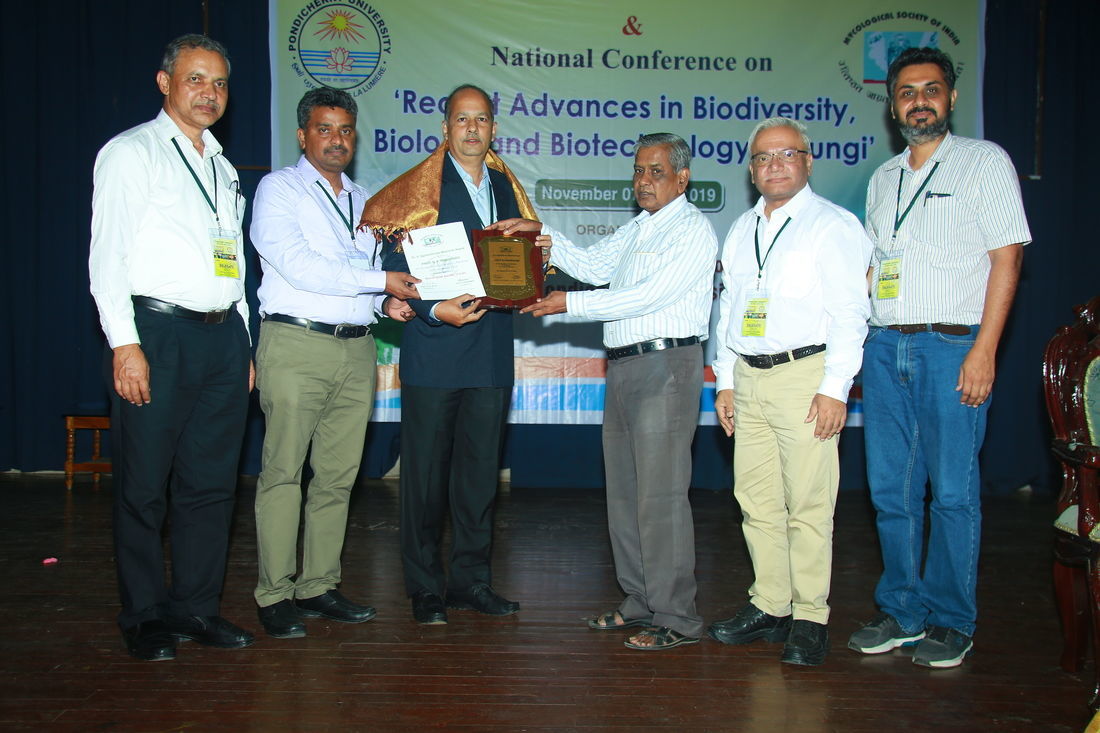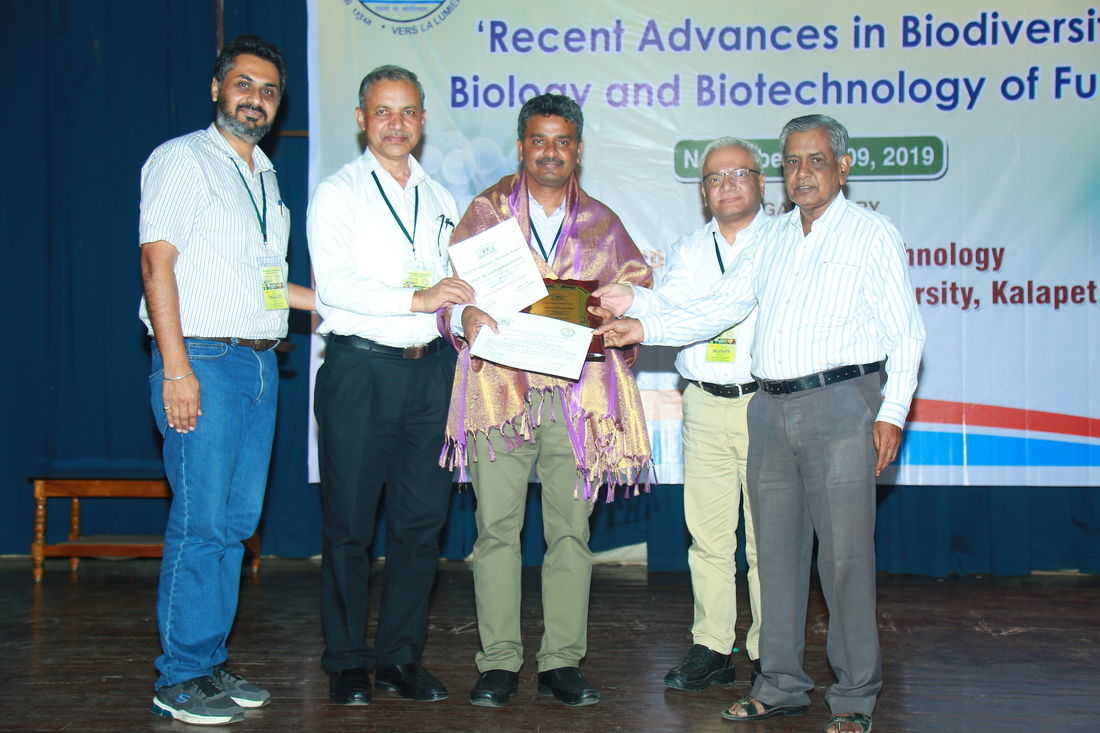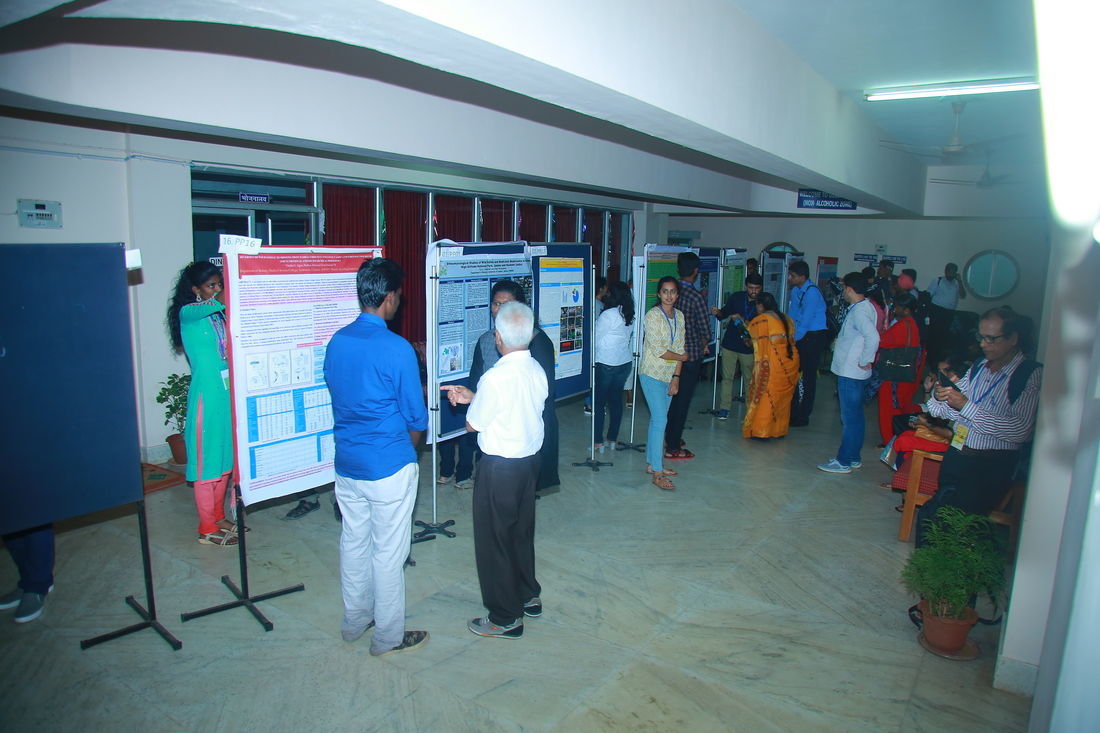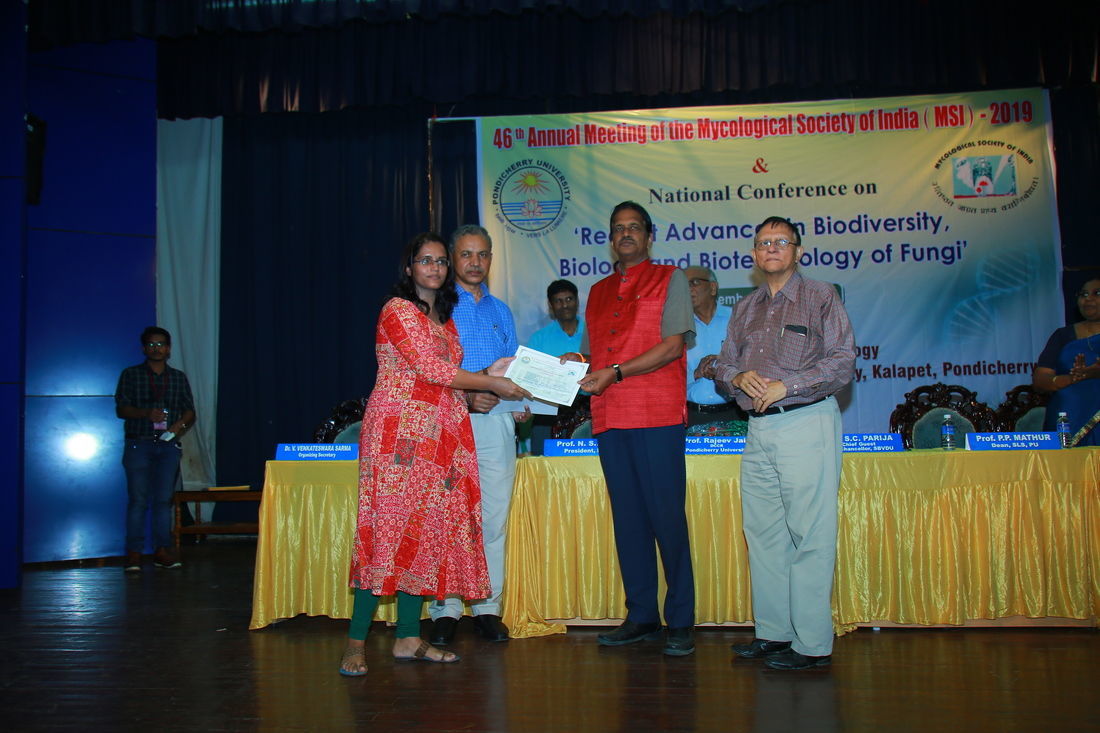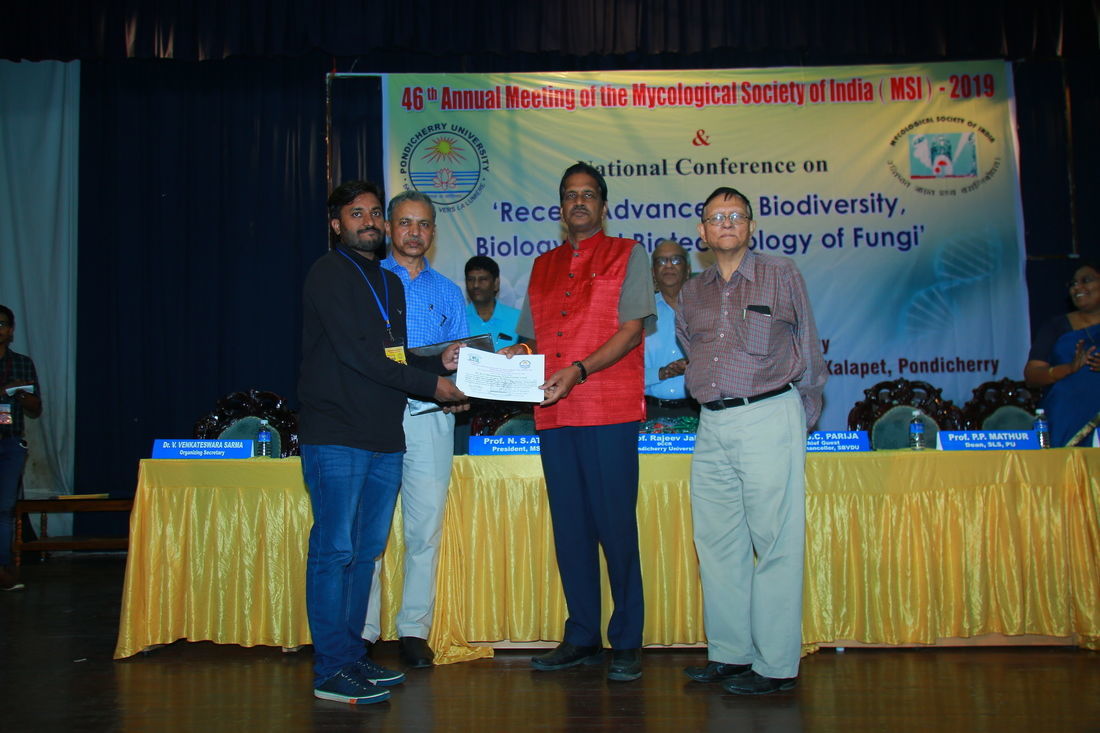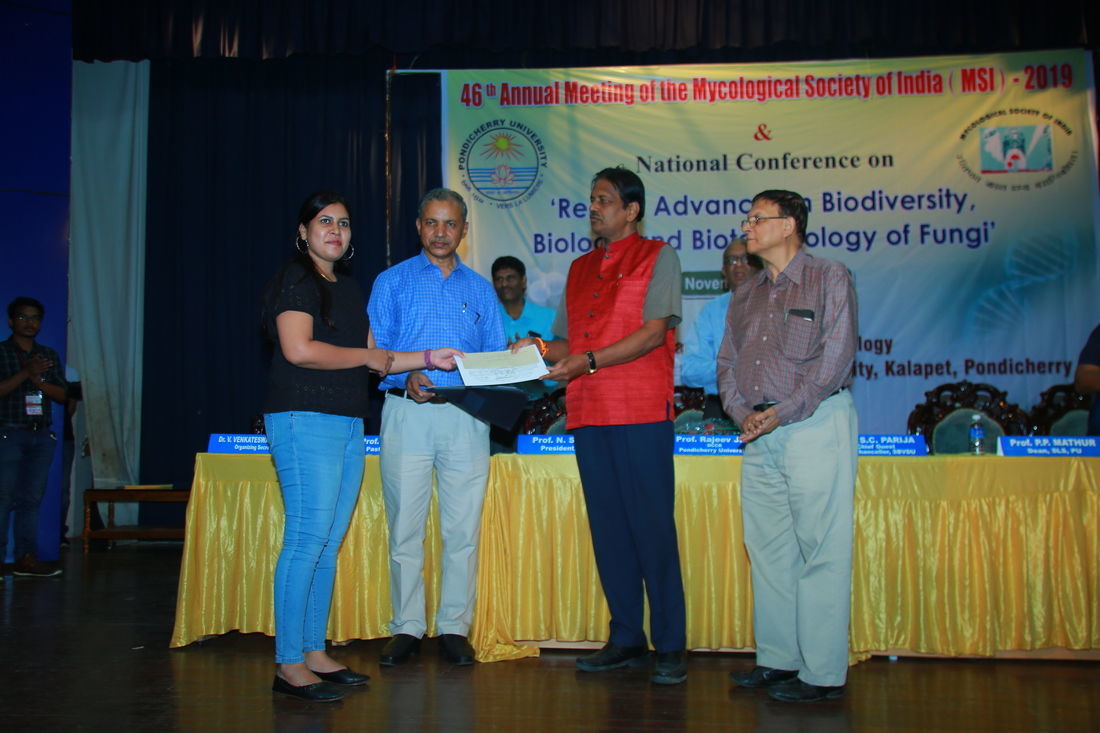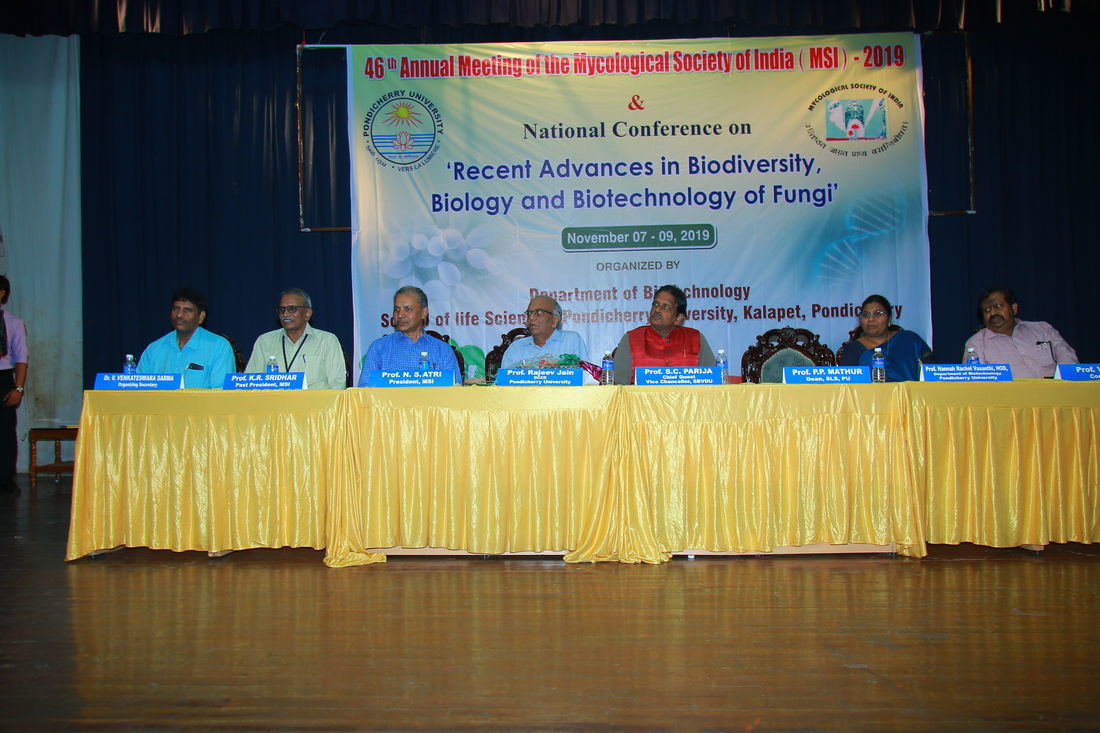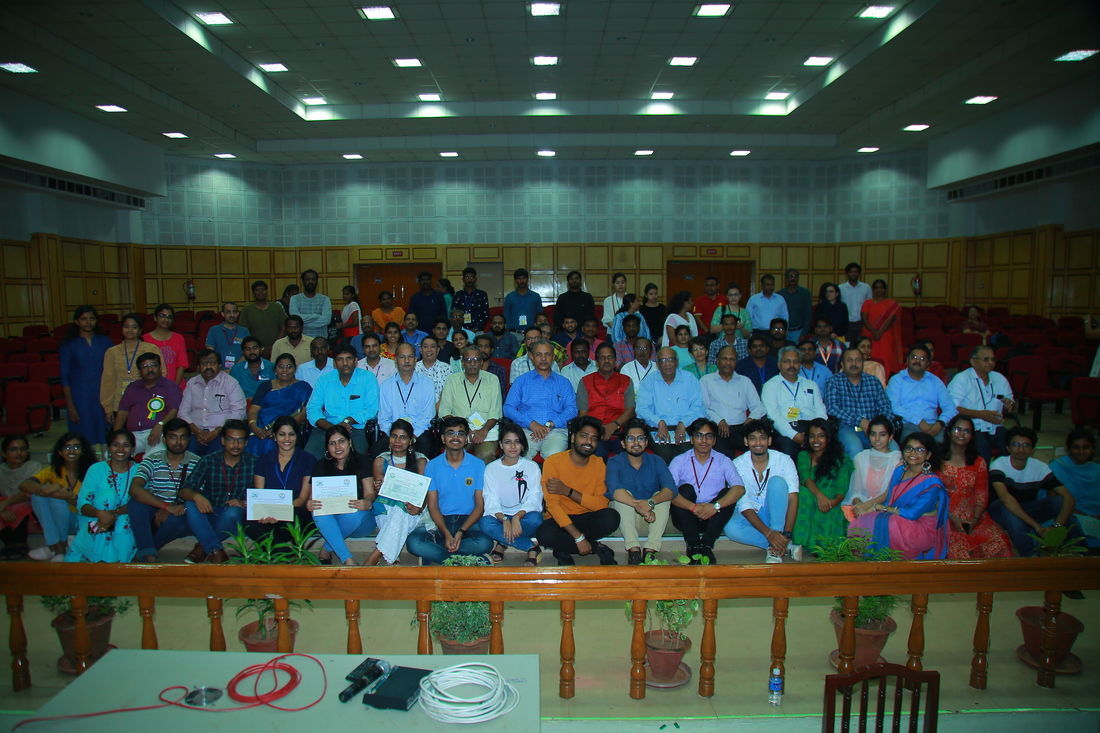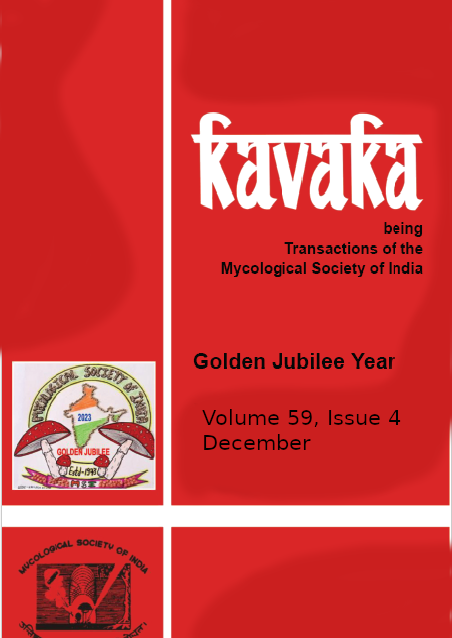From the Editor's Desk
Dear MSI members, at the outset, on my own behalf and on behalf of MSI members I wish to congratulate Dr. H.C.Gugnani (New Delhi), Dr. T.S.Suryanarayana (Chennai), Dr. T. Satyanarayana (New Delhi), Dr. K.R.Sridhar (Mangalore), Dr. N.K. Dubey (Varanasi), Dr. Chandralata Raghukumar (Goa), Dr. Absar Ahmad (Aligarh), Dr. R.S. Singh (Patiala), Dr. M.K. Rai (Amravati), Dr. Krishnendu Acharya (Kolkata) and Dr. Rupam Kapoor (New Delhi) for recognition of their contributions amongst top 2% scientists of the world in their respective chosen field of specialization in an independent study done by Stanford University, California. Through this recognition they have brought honor to Indian Mycology in general and Mycological Society of India in particular. This is my last issue as Editor in Chief of this prestigious Journal whose foundation was laid in the year 1973 by none other than some well known stalwarts of Indian Mycology including Late Professor C.V. Subramanian, whose blessing I was fortunate enough to get when I took over as Editor of Kavaka in 2014. Before my taking over as Editor, only one issue of the journal was being published. After 2014 we regularly brought out two issues of Kavaka on annual basis. During these years, besides publication of “The pursuit of Mycology in the Tropics: Recollections” by Late Professor C.V. Subramanian (2015), Commemoration volumes were also published in honour of Late Dr. M. J. Thirumalachar (2014), Late Professor K.S. Thind (2016), Late Professor S.B. Saksena (2017), Late Professor B.P.R.Vittal (2019) and Late Professor John Paul Muthumary (2019). Because of the quality contributions from Indian and some foreign mycologists in different issues of the journal, Kavaka is in the recognized UGC CARE list of Journals and is presently rated with 5.30 by NAAS, New Delhi and also indexed in Indian Citation Index. We need to work hard so as to improve its rating and inclusion in the indexing sites including SCOPUS and WEB OF SCIENCE.
For all the support I received from members of Editorial Board, MSI members, contributors of the manuscripts and reviewers during my tenure as Editor and then Editor in Chief, I would like to express my sincere gratitude. With great sense of satisfaction I express my indebtedness to Dr. Avneet Pal Singh (Managing Editor) for meticulously managing various jobs during the editorial and indexing process including the printing of the journal, to Mr. Lakhvir Singh (Technical Assistant) for computer setting of the manuscripts, to Head Department of Botany, Punjabi University, Patiala for logistic support, to Shaheed-eAzam Press & Hospitality, Patiala for timely printing of the journal issues and to Mr. Nishu Sharma for successfully handling and timely updating the Journal and the Society Website. Without their unflinching support, the journal may not have reached the level it is today.
Since I have left Patiala after completing my Re-employment as Professor in the Botany Department and joined Shoolini University at Solan in Himachal Pradesh, I have relinquished the charge of Editor in Chief of Kavaka. From January, 2021 onwards Professor Yash Pal Sharma (email: This email address is being protected from spambots. You need JavaScript enabled to view it.) of Department of Botany, University of Jammu, Jammu will take over as new Editor in Chief of the journal. From January 1, 2021 onwards all communication concerning publication of manuscripts in Kavaka being Transactions of Mycological Society of India be addressed to him. My best wishes to Dr. Sharma and his team for success in future endeavors for taking the Journal to still greater pedestal. I request all the MSI members to give the new Editor in Chief same level of support and encouragement which I was lucky enough to garner during my tenure first as Editor and then as Editor in Chief of Kavaka.
December 31, 2020
N.S. Atri
(Editor in Chief KAVAKA)
Professor, School of Biological and Environmental Sciences
Shoolini University of Biotechnology and Management Sciences
Solan-173229 (H.P.), INDIA
![]()
Contents  |
Front-pages  |
![]()
doi:10.36460/Kavaka/55/2020/1-11
KAVAKA 55: 1-11 (2020)
Lessons from 50 years describing and classifying fungi
David L. Hawksworth
Honorary President, International Mycological Association
Comparative Plant and Fungal Biology, Royal Botanic Gardens, Kew, Surrey, TW9 3DS, UK; Department of Life Sciences, The Natural History Museum, Cromwell Road, London, SW7 5BD, UK; Jilin Agricultural University, Changchun, Jilin Province, 130118 China.
Corresponding author Email: This email address is being protected from spambots. You need JavaScript enabled to view it.
(Submitted on October 10, 2020; Accepted on November 15, 2020)
ABSTRACT
This contribution reflects on ten lessons learned during the 50 years since the author first described a new fungal taxon. These are: (1) It is easier to describe something as new than to find out if it has already been described; (2) Examine as many specimens and cultures as you can; (3) Study as many characters with as many techniques as possible – in the field as well as the laboratory; (4) Formulate species concepts before examining types; (5)Taxonomic ranks are a human construct; (6) Make the international Code work for you; (7) Always deposit isotypes and preserve vouchers for unusual records; (8) Check measurements of microscopic features; (9) Do not be afraid to challenge current ideas and present new hypotheses; and (10) Do not submit your paper right away and choose an appropriate journal. It is hoped these may prove of value to those in early stages of a career in fungal systematics.
Keywords: Cultures, Good practice, International Code of Nomenclature, Nomenclature, Species concepts, Systematics, Taxonomy, Type specimens, Voucher specimens
![]()
doi:10.36460/Kavaka/55/2020/12-17
KAVAKA 55: 12-17 (2020)
Zoonotic Dermatophytes and Changing Epidemiology of Dermatophytosis in West Africa, an update
Adebowale I Adebiyi1 and Harish C Gugnani*2
1Department of Veterinary Microbiology, University of Ibadan, Ibadan -200284, Nigeria
2Med. Mycology Unit, Department of Microbiology, Vallabhbhai Patel Chest Institute, University of Delhi, Delhi-110007, India . Present Address: J 3/45, Rajouri Garden, New Delhi-110027, India
*Corresponding author Email: This email address is being protected from spambots. You need JavaScript enabled to view it.
(Submitted on August 03, 2020; Accepted on October 20, 2020)
ABSTRACT
In some resource poor countries continuous increase in the traditional practices, such as livestock rearing system, crowded-living and poor housing conditions have heightened uncontrolled access to the infected or asymptomatic animals and increase in the spread of fomites. Consequently, zoonotic fungi can be naturally transmitted between animals and humans, and in some cases cause significant public health problems. Thus, an appraisal of dermatophytosis considered as one of the most common zoonotic infections in humans and animals is needed to realize the burden of this disease in West Africa. A thorough search of existing literature was carried out using the Google search engine and PubMed electronic database to identify and review relevant publications on zoonotic dermatophytosis in West Africa by using the keywords ‘dermatophytosis or ‘dermatophytes’ and ‘West Africa’. The Boolean operator ‘AND’ was used to combine and narrow the searches. Available publications were subsequently reviewed and the findings qualitatively described.Our findings which revealed that dermatophytosis remains a significant infectious condition with varying social and cultural burdens leading to decreased cost value of animals as well as serious outbreaks of diseases in human and animal populations, predisposed by poor traditional practices. Among various factors, continuous increase in livestock keeping, interaction with animals due to socioeconomic and cultural reasons in resource poor countries and rearing of animals in order to augment economic status and livelihood, may continue to play an important role in the occurrence of dermatophytosis. Thus, there is a need to encourage multisectoral approach to investigate epidemiology of dermatophytosis including the role of zoophilic dermatophytes in West Africa.
Keywords: Zoonotic dermatophytes, Dermatophytosis pathobiology, epidemiology, West Africa
![]()
doi:10.36460/Kavaka/55/2020/18-27
KAVAKA 55 :18 -27 (2020)
Investigation on the performance of Cedrus deodara seedlings artificially inoculated with the mycorrhizal associate Rhizopogon himalayensis
Lal Singh1, Ashwani Tapwal2, J.S. Thakur3 and T.N. Lakhanpal4*
1Himalayan Research Group, Chotta Shimla, H.P. -171002
2 Himalayan Forest Research Institute, Shimla-171013
3,Govt. College Banjar, Kullu, H.P. 175123
4 Dept-. of Biosciences, Himachal Pradesh Univ., Shimla-171005
*Corresponding author Email: This email address is being protected from spambots. You need JavaScript enabled to view it.
(Submitted on May 25, 2020; Accepted on October 10, 2020)
ABSTRACT
Performance of the seedlings of Cedrus deodara artificially inoculated with Rhizopogon himalayensis was evaluated in three sets of soils viz.: forest soil, wasteland soil, and mixed soil. It was observed that the growth and development of inoculated and uninoculated seedlings were almost similar till the age of 2½ months except that the seedling height and root length were significantly higher in the inoculated seedlings. The inoculated seedlings attained a height of 25-30 cm within 6 months whereas the seedlings with natural inoculum attained the same in 18-24 months, exhibiting an incredibly significant difference. Similarly, the inoculated seedlings excelled the seedlings with natural inoculum in collar diameter, fresh and dry weight of shoot and root. Concerning soils, the wasteland soil when used in mixture with natural zone soil produced better seedlings with quality growth characteristics. Therefore, it can be concluded that seedlings inoculated with R. himalayensis performed better in growth and development than those with natural inoculum.
Keywords: Rhizopogon himalayensis, Trappeindia himalayensis, Cedrus deodara, mycorrhiza, artificial inoculation, N.W. Himalaya.
![]()
doi:10.36460/Kavaka/55/2020/28-35
KAVAKA 55: 28-35 (2020)
Osmoadaptive Strategies in Halophilic Fungi
Valerie Gonsalves1,2* and Sarita W. Nazareth1
1Department of Microbiology, Goa University, Taleigao Plateau, Goa, India.
2Department of Microbiology, St. Xavier’s College, Mapusa, Goa, India
*Corresponding author Email: This email address is being protected from spambots. You need JavaScript enabled to view it.
(Submitted on November 10, 2020; Accepted on December 20, 2020)
ABSTRACT
Osmoregulatory mechanisms are essential for fungi to survive in hypersaline environments. The osmoregulatory mechanisms, namely ‘organic osmolyte’ and ‘salt-in-cytoplasm’ mechanisms were studied in obligate and facultative halophilic fungi isolated from various athalassohaline, thalassohaline and polyhaline econiches, as a response when grown at solar salt concentrations optimal for their growth, as well as one concentration below and one above the optimal. All the halophilic fungi accumulated sugars sucrose and trehalose, and polyols erythritol, ribitol, arabitol, xylitol, inositol, mannitol, and dulcitol at each of these salt concentrations. An increase in the solar salt concentrations in the growth medium resulted in an increase in the total concentration of osmolytes accumulated by the mycelia; a positive correlation was also seen with individual osmolytes. These fungi showed low intracellular accumulation of sodium and potassium cations, which may therefore not contribute significantly in osmoregulation; however, a high concentration of Na+ was detected on the fungal cell wall, indicating this to be a protective mechanism for the fungal cell. This indicates that the halophilic fungi examined are essentially osmo-conformers, operating on a mechanism of organic osmolyte accumulation for adaptation to hypersaline environments.
Keywords: Compatible solutes, salt-in-cytoplasm, obligate halophilic fungi, facultative halophilic fungi
![]()
doi:10.36460/Kavaka/55/2020/36-38
KAVAKA 55:36-38 (2020)
Effect of Carbon Nutrition on the vegetative growth of Cylindrocladium parvum
C. Manoharachary
Department of Botany, Osmania University, Hyderabad-500007, Telangana
Corresponding author Email: This email address is being protected from spambots. You need JavaScript enabled to view it.
(Submitted on October 20, 2020; Accepted on December 12, 2020)
ABSTRACT
Cylindrocladium parvum P. J. Anderson is known to cause leaf spot disease on Eucalyptus sp. collected from Bhadrachalam. This pathogen has not been worked out for its carbon nutritional requirements. Therefore, an attempt has been made to study the efficacy of Glucose and Fructose (Monosaccharides), Maltose and Sucrose (Disaccharides) on the growth and sporulation of this pathogenic fungus. Fructose was found to support highest growth in comparison to other monosaccharide and disaccharide sugars evaluated.
Keywords: Cylindrocladium parvum, disaccharides, Eucalyptus monosaccharides, carbon nutrition.
![]()
doi:10.36460/Kavaka/55/2020/39-49
KAVAKA 55: 39-49 (2020)
Bioactive Metabolites of Endophytic fungi of Avicennia marina (Forssk.) Vierh.
*Sunil Kumar Deshmukh1,2, Manish Kumar Gupta3 and V.Venkateswara Sarma4
1TERI-Deakin Nano Biotechnology Centre, The Energy and Resources Institute (TERI), Darbari Seth Block, IHC Complex, Lodhi Road, New Delhi 110003, India
2Agpharm Bioinnovations LLP, Science & Tech Entrepreneurs Park, Thapar institute of Engineering & Technology, Patiala, Punjab 147001
3SGT College of Pharmacy, SGT University, Gurugram-122505 (HR), India
4Department of Biotechnology, Pondicherry University, Kalapet, Pondicherry-605014, India
*Corresponding author Email: This email address is being protected from spambots. You need JavaScript enabled to view it.
(Submitted on November 15, 2020; Accepted on December 26, 2020)
ABSTRACT
Endophytic fungi are microorganisms residing within the plant without causing any harm to the host plants. These fungi are known to produce diverse classes of chemical compounds with useful biological activities. Avicennia marina (Forssk.) Vierh. is a mangrove plant belonging to family Acanthaceae and used in traditional medicine. Mangrove plant A. marina harbors a large number of endophytic fungi which are known to produce an array of biologically active heterocyclic compounds. In the present review nearly 135 compounds reported from the endophytic fungi associated with mangrove plant A. marina are highlighted. These compounds were isolated from the species of genera Xylaria, Aspergillus, Penicillium, Stemphylium, Cladosporium, Phoma, and an unidentified fungus.
Keywords: Endophytic fungi, Avicennia marina, bio-active compounds, Xylaria, Penicillium
![]()
doi:10.36460/Kavaka/55/2020/50-57
KAVAKA 55: 50-57 (2020)
Application of digital colorimeter for preliminary characterization of gold nanoparticle swarms produced by Termitomyces heimii using a novel Bioinspired Microfluidics assay
Sujata Dabolkar and Nandkumar M. Kamat*
Mycological Laboratory, Department of Botany, Goa University, Taleigao Goa-403206, India
*Corresponding author Email: This email address is being protected from spambots. You need JavaScript enabled to view it.
(Submitted on July16, 2020; Accepted on October 29, 2020)
ABSTRACT
Fungi appear to be promising for large scale production of nanoparticles (NPs) as these are simpler to grow both in the laboratory and at industrial scale. This paper reports a novel microfluidics based assay system to detect Gold bioreduction capacity of different tissues in tissue based and cell free environment. Using sterile microtestplate, different tissues of Termitomyces heimii Natarajan mature fruitbodies were tested for bioreduction with 200 μL chloroauric acid (one mM) at an interval of 5,10, 15, 30, 45, 60, 120 min and 12, 24 and 48 hours. The results in terms of production of distinct nanoparticles were directly visualized microscopically and using mobile based digital colorimeter. Membrane filtered sterile water-soluble extracts (SWSE) from the same tissues were similarly screened. The results manifested by mono and polydisperse GNPs and microparticles of mixed size groups demonstrated that cell free system is potentially useful for bioinspired fabrication of GNPs.
Keywords: Microfluidistic assay, gold, bioreduction, termitophilic mushrooms
![]()
doi:10.36460/Kavaka/55/2020/58-64
KAVAKA 55: 58-64 (2020)
Onychomycosis caused by Fusarium concentricum Nirenberg & O’ Donnell and Fusarium proliferatum (Matsush.) Nirenberg in primary school children
Anjali Sharma and Geeta Sumbali*
Department of Botany, University of Jammu, BR Ambedkar Road Jammu-180006 (India)
*Corresponding author Email: This email address is being protected from spambots. You need JavaScript enabled to view it.
(Submitted on August 29, 2020; Accepted on October 24, 2020)
ABSTRACT
In the present study, two cases of onychomycosis (fungal nail infection) caused by Fusarium concentricum and Fusarium proliferatum in school children of Kalakot (Rajouri, J&K) are described. The onychomycotic isolates were identified on the basis of cultural characters, diagnostic morphological features and by molecular characterization. Both these fusarial species are of uncommon occurrence and have not been recorded earlier as onychomycotic agents among children. The risk of nail contamination among children may be attributed to their careless behavior towards cleanliness and frequently playing with the soil, which is an important reservoir of Fusarium species.
Keywords: Onychomycosis, children, NCBI-Blast, Fusarium concentricum, F. proliferatum
![]()
doi:10.36460/Kavaka/55/2020/65-70
KAVAKA 55: 65-70 (2020)
Two new records of Genus Agaricus from Western Ghats forests of India
R. Kantharaja, K. J. Nandan Patel, M. Krishnappa*
Department of PG Studies and Research in Botany, Kuvempu University, Jnana Sahyadri, Shankaraghatta, Shivamogga, Karnataka 577 451, India
*Corresponding author Email: This email address is being protected from spambots. You need JavaScript enabled to view it.
(Submitted on July 25, 2020; Accepted on October 10, 2020)
ABSTRACT
Two species of the genus Agaricus L., each from Sect. Brunneopicti Heinem. (A. Chiangmaiensis Karun., Guinb. and K.D. Hyde) and Sect. Arvenses (Konrad and Maub.) Konrad and Maub. (A. flocculosipes R.L. Zhao, Desjardin, Guinb. and K.D. Hyde) newly reported from India. The specimens were collected from different parts of Central Western Ghats and studied by morphological, microscopic and molecular phylogenetics using nrITS and nrLSU sequences. The current study presents the descriptions, color photographs, and phylogenetic relationships.
Keywords: Agaricales; floccose; ITS; morpho-molecular; taxonomy, Western Ghats.
![]()
doi:10.36460/Kavaka/55/2020/71-76
KAVAKA 55 : 71-76 (2020)
Isolation and identification of phosphate (P) solubilizing halophytic fungal endophytes
Apurva Sawant and B.F. Rodrigues*
Department of Botany, Goa University, Taleigao Plateau, Goa 403 206.
*Corresponding author Email: This email address is being protected from spambots. You need JavaScript enabled to view it.
(Submitted on June 20, 2020; Accepted on September 30, 2020)
ABSTRACT
Mangrove endophytes are an essential group of halophytic fungi involved in the solubilization of inorganic phosphate (P) into available organic form of P. In the present study, the diversity of potential P solubilizing fungal endophytes was studied by using Pikovskaya’s media. The highest colonization of endophytic fungi was recorded in Avicennia officinalis. A total of 37 fungal taxa representing 15 genera were isolated along with seven sterile non-sporulating isolates. The relative abundance (RA) and isolation frequency (IF) were recorded highest in Aspergillus niger (MEn27) and Scolecobasidium sp. (MEn39). It was observed that Shannon-Weiner (H) and Simpson diversity index (D) was 1.5 and 1, respectively. Fungal isolates showed positive P solubilizing activity in solid and liquid media. The highest P solubilization potential was recorded in Drechslera sp. A significant decrease in the pH of the liquid media from 7 (un-inoculated control tubes) to 3.11 was observed. The results indicated the potency of endophytic fungi to solubilize P.
KEYWORDS: Mangroves, tropical ecosystem, endophytic fungi, Pikovskaya media, phosphate solubilization.
![]()
doi:10.36460/Kavaka/55/2020/77-83
KAVAKA 55: 77-83 (2020)
Cultivation of a wild strain of Schizophyllum commune on agro-industrial wastes
Sanjit Debnath1*, Sanchita Bhattacharya1, Panna Das2 and Ajay Krishna Saha1
1Mycology and Plant Pathology Laboratory, Department of Botany, Tripura University, Suryamaninagar-799 022, Tripura, India.
2Microbiology Laboratory, Department of Botany, Tripura University, Suryamaninagar-799 022, Tripura, India.
*Corresponding author Email: This email address is being protected from spambots. You need JavaScript enabled to view it.
(Submitted on June 24, 2020; Accepted on November 17, 2020)
ABSTRACT
The widely distributed macrofungal species Schizophyllum commune Fr. is one of the important mushrooms due to its diverse biological properties. The primary aim of this study was to collect and culture S. commune from the wild, taxonomically investigate, identify, cultivate, and evaluate its productivity and biological efficiency on natural substrate. The results revealed that sawdust with rice bran (1:1) was the most suitable substrate for cultivation of S. commune amongst the tested substrates with productivity ranging from 3.926-6.322 % and biological efficiency from 7.55-12.157 %. S. commune is an easily cultivable wild edible mushroom and is a good source of nutraceuticals and medicines for maintaining and promoting human health.
KEYWORDS: Split gills, mushroom, agro-residues waste, cultivation techniques.
![]()
doi:10.36460/Kavaka/55/2020/84-90
KAVAKA 55: 84-90 (2020)
Efficacy of Impression (Tricyclazole 45%+Hexaconazole 10%WG) against Fruit rot (Colletotrichum sp.) and Leaf spot (Alternaria and Cercospora) of Pomegranate under field condition
Suresh D. Ekabote1*, Pruthviraj2, Divyajyothi, U3 and Nalina, S. O.4
1Department of Horticulture Crop Protection, College of Horticulture, Hiriyur, UAHS, Shivamogga
2Department of Plant Pathology, College of Agriculture, Shivamogga, UAHS, Shivamogga
3ZBNF, ZAHRS, Babbur farm, Hiriyur
4Department of Horticulture Crop Protection, College of Horticulture, Hiriyur
*Corresponding author Email: This email address is being protected from spambots. You need JavaScript enabled to view it.
(Submitted on June 26, 2020; Accepted on November 27, 2020)
ABSTRACT
The pomegranate (Punica granatum L.), Is one of the ancient and highly priced favorite fruit which belongs to family Lythraceae of order Myrtales and it is mainly grown in tropical and subtropical regions of the world. In recent years, successful cultivation of pomegranate is faced by many constraints, among them, pest and diseases are the major ones. Common diseases of pomegranate leaf and fruits include Anthracnose and Cercospora and Alternaria leaf spot and these diseases cause severe loss to pomegranate crop. Therefore, a field experiment was carried out on the effect of Tricyclazole 45%+Hexaconazole 10%WG against leaf spots and fruit rot of pomegranate during 2018-19 and 2019-2020 at College of Horticulture, Hiriyur. Experimental results revealed that all the treatments significantly reduced the leaf spots and fruit rot disease severity over untreated control. Tricyclazole 45%+Hexaconazole 10%WG@ 1.25 gm/L was most effective in the management of leaf spots (9.64 and 12.00 PDI) and anthracnose of pomegranate (7.17 and 12.87 PDI), respectively followed by the same fungicide @ 1.00gm/L with a yield of 5.24 tons/ha and 5.64 tons/ha, respectively
Keywords: Cercospora and Alternaria leaf spot, Anthracnose, Tricyclazole + Hexaconazole
![]()
doi:10.36460/Kavaka/55/2020/91-100
KAVAKA 55: 91-100 (2020)
Plant growth promoting activities of soil fungi resistant to synthetic fertilizers
Ramasamy Vijayakumar*1, Kasinathan Karthika1 and Rajendran Senthilkumar2
1Department of Microbiology, Government Arts and Science College, Perambalur - 621 107, Tamilnadu, India.
2Department of Microbiology, P.G. Extension Centre, Bharathidasan University, Perambalur - 621 107, Tamilnadu, India
*Corresponding author Email: This email address is being protected from spambots. You need JavaScript enabled to view it.
(Submitted on May 5, 2020; Accepted on October 29, 2020)
ABSTRACT
The present study assessed the growth promoting activities of regional soil fungi resistant to chemical fertilizers; besides it also evaluated the resolving sensitivities of the origami optical microscope-Foldscope. Regional agricultural fields derived soil samples were assessed for their physico-chemical parameters and were subsequently processed to isolate the soil fungi. The morphologically identified fungal isolates were also studied microscopically using the Foldscope, a modern microscopic tool. Further, the predominant fungi of the soil were studied for their growth ability on various culture media, different pH levels and temperature regimes. Impacts of various synthetic fertilizers on the growth of the test fungal isolates were also evaluated. The findings showed that Trichoderma harzianum and Aspergillus niger were the most common isolates from all the sampling sites of Tamilnadu State, India, and were also the most resistant mycoflora against the synthetic fertilizers applied to the agricultural soil. In addition, the plant growth promoting properties of the predominant fungi associated with Vigna mungo crop plant were also described.
Keywords: Foldscope, soil fungi, fertilizers tolerance, plant growth promoting activity, Vigna mungo.
doi:10.36460/Kavaka/55/2020/101-107
KAVAKA 55: 101-107 (2020)
Species Richness of Macrofungi and Ethnomycological Studies in Chitlang, Makwanpur, Central Nepal
Priyanka Shah*, Hari Prasad Aryal and Tej Bahadur Darji
Central Department of Botany, Tribhuvan University, Kirtipur, Kathmandu, Nepal
*Corresponding author Email: This email address is being protected from spambots. You need JavaScript enabled to view it.
(Submitted on August 23, 2020; Accepted on December 10, 2020)
ABSTRACT
Macrofungi, the most diverse groups of organisms on earth constitute a significant part of terrestrial ecosystems. Wild edible mushrooms are important non-timber forest products, a potential source of income in terms local trade and export. Inspite of their significant role in ecosystems they are facing threat of extinction due to environment destruction. The main objective of this research is to explore the species richness and indigenous knowledge of macrofungi in the study area. The study was conducted from July to September 2019 in Chitlang, Makwanpur. Field investigation was done by using systematic random sampling where plot of 10×10 m2 were layed in line transect at 1600 m, 1800 m and 2000 m. A participatory rural appraisal technique was adopted to obtain information largely on ethnomycological aspects. This investigation explored the diversity of higher fungi with their identification, documentation and utilization. The study reported 129 species belonging to 41 families, 70 genera and 13 orders. The research revealed the use of 13 species of mushroom by the local respondents. Species richness of macrofungi increases with increase in soil moisture, litter cover, soil carbon but the relation between canopy cover and species richness was not significant.
KEYWORDS: Altitudinal gradients, phosphate solubilization, subtropical ecosystem.
![]()
doi:10.36460/Kavaka/55/2020/108-111
KAVAKA 55: 108-111 (2020)
A New Species of Scytalidium Pesante on Diospyros melanoxylon Roxb. from Central India
Neha Awasthi1*, Anurag Dubey2, Smriti Bhardwaj2 and Akhilanand Rai2
1Dept. of Botany, Govt. Naveen College, Nowgong, Chhatarpur,MP, India
2Laboratory of Mycotaxonomy, Dept. of Botany, School of Biological Sciences, Dr. Harisingh Gour Central University, Sagar, MP, India.
*Corresponding author Email: This email address is being protected from spambots. You need JavaScript enabled to view it.
(Submitted on June 20, 2020; Accepted on October 12, 2020)
ABSTRACT
During the mycological survey of Garhpehra forest, Sagar, MP, India, a new species of Scytalidium Pesante was encountered on Diospyros melanoxylon Roxb. The material was subsequently worked out, described, illustrated and identified. After a thorough survey of literature, it was found to be a novel species of Scytalidium which have been named as Scytalidium melanoxylicola sp. nov. Photomicrographs and camera lucida drawings of the investigated fungus has also been provided.
Keywords: Arthrospores, Chlamydospores, Scytalidium, trichomes
![]()
doi:10.36460/Kavaka/55/2020/112-118
KAVAKA55: 112-118 (2020)
Utility of agro-residues to produce xylanase by Penicillium citrinum MTCC 9620 in solid state fermentation
Jyosthna Khanna Goli and Hameeda Bee*
Department of Microbiology, Osmania University, Hyderabad- 500007
*Corresponding author Email: This email address is being protected from spambots. You need JavaScript enabled to view it.
(Submitted on September 5, 2020; Accepted on November 27, 2020)
ABSTRACT
Wheat bran was found to be the best substrate, for cellulase free endo-1, 4-β-xylanase production by solid state fermentation (SSF) using Penicillium citrinum MTCC 9620. One factor at a time (OFAT) approach was carried out to optimize process parameters for xylanase production by SSF, resulting in xylanase production of 405U/gds after 96 h of incubation at 30°C, 80% moisture with urea as source of nitrogen and maltose as a co-substrate (additional carbon source). Further, statistical approach by Box–Behnken design was used for optimization of pH, incubation time, biomass concentration and moisture content to obtain maximum xylanase yield of 1225U/gds at PH 6, with 1g biomass, 80% moisture and incubation time of 4 days, respectively. The xylanase production by statistical approach was found to be 3fold higher in comparison to OFAT approach.
KEYWORDS: Solid state fermentation, OFAT, statistical approach, optimization, Box Behnken design
![]()
doi:10.36460/Kavaka/55/2020/119-120
KAVAKA 55: 119-120 (2020)
Maheshwaramyces cryptocaryae sp. nov. (Lembosiaceae, Asterinales, Ascomycota) on Cryptocarya wightiana Thw. from Goodrical Reserve, Ranny forest, Kerala, India
Jacob Thomas* and Nisha Mathew
PG & Research Dept. of Botany, Mar Thoma College, Kuttappuzha P O, Tiruvalla 689103, Kerala, India
*Corresponding author Email: This email address is being protected from spambots. You need JavaScript enabled to view it.
(Submitted on July 20, 2020; Accepted on October 12, 2020)
ABSTRACT
In this paper a new foliicolous fungal species of genus Maheshwaramyces, namely Maheshwaramyces cryptocaryae sp. nov., was found infecting the leaves of Cryptocarya wightiana Thw. (Lauraceae). The newly named fungus belongs to the family Lembosiaceae of the order Asterinales.
KEYWORDS: New species, Maheshwaramyces, Lembosiaceae, taxonomy, fungi, Western Ghats
![]()
doi:10.36460/Kavaka/55/2020/121-127
KAVAKA 55 : 121-127 (2020)
Some more additions to the mycotoxin profile of dried red chillies from Union Territory of Jammu and Kashmir
Shallu Samyal and Geeta Sumbali*
Department of Botany, Govt. College for Women Parade Ground, Jammu 180001, India.
*Department of Botany, University of Jammu, Jammu, Pin- 180006, India
Corresponding author Email: This email address is being protected from spambots. You need JavaScript enabled to view it.
(Submitted on October 20, 2020; Accepted on December 10, 2020)
ABSTRACT
A study was undertaken to isolate and enumerate species of Aspergillus and Penicillium and their toxic secondary metabolites associated with the pericarp of dried red chillies sampled from Jammu and Kashmir (UT). To recover maximum species, three different media, viz., Czapek Dox Agar (CDA), Dichloran 18% Glycerol Agar (DG-18), and Malt Salt Agar (MSA) were used. Mycoflora assessment indicates that chilli pericarp is capable of harbouring a number of species belonging to these two genera and their perfect states. Overall, Aspergillus and Penicillium were equally represented by 15 species each, followed in decreasing order by their perfect states, Eurotium and Emericella, which were represented by three and two species, respectively. In view of the detection of fungal species, which are known producers of toxic metabolites, the samples were investigated for some more toxins like ochratoxin A, patulin and citrinin by using multimycotoxin method and HPLC analyser. Results revealed the presence of all the three toxins in 15-70 per cent samples. Detection of these mycotoxins from the dried red chillies marketed in Jammu and Kashmir is of great concern as it is an important spice of commerce, which is used daily in almost every household for cooking and seasoning.
KEY WORDS: Chilli pericarp, Aspergillus, Penicillium, ochratoxin A, patulin, citrinin.
![]()
doi:10.36460/Kavaka/55/2020/128-133
KAVAKA 55: 128-133(2020)
A new species of Rhizopogon from Kashmir valley, India
Mehrajud Din Talie, Abdul Hamid Wani, Wasim Sajad Malik, Mohd Yaqub Bhat*
Department of Botany, Section of Mycology and Plant Pathology, University of Kashmir, Srinagar (190006), India.
*Corresponding author Email: This email address is being protected from spambots. You need JavaScript enabled to view it.
(Submitted on September 21, 2020; Accepted on December 7, 2020)
ABSTRACT
A new species of Rhizopogon Fr. & Nordholm, R. cashmerianus associated with Pinus wallichiana was collected and identified for the first time from Kashmir Himalaya. It was characterized and identified on morpho-anatomical and molecular basis by analysis of ITS sequences. The fungal molecular marker (ITS-rDNA) was amplified using universal fungal primers (ITS1F and ITS4R). Bioinformatic data retrieved for its molecular identification and the rDNA sequence, when aligned in GenBank by performing BLAST indicates that R. cashmerianus is a new species. The rDNA sequence of this species forms a distinct clade from the rest of species of the same genus. Therefore, this species is being described for the first time from Kashmir Valley.
KEYWORDS: Molecular identification, morpho-anatomical characterization, phylogenetic analysis, Rhizopogon.
![]()
doi:10.36460/Kavaka/55/2020/134-138
KAVAKA 55: 134-138 (2020)
Effect of Foliar Application of Phosphorus on Rhizosphere and Rhizoplane Fungal diversity in Brassica juncea
Walay Y. Tagade1*, M. V. Kawale2, R. B. Zode3 and R. P. Thakre4
1,3 Department of Botany, C.J. Patel College, Tirora, Dist- Gondia, Maharashtra-441911
2Department of Botany, Dhote Bandhu Science College, Gondia, Maharashtra-441614
4Department of Botany, RTM Nagpur University, Nagpur, Maharashtra- 440033
*Corresponding author Email: This email address is being protected from spambots. You need JavaScript enabled to view it.
(Submitted on July 2, 2020; Accepted on November 9, 2020)
ABSTRACT
The microbial communities, also called as microhabitat, play an important role in the growth and development of the plants. The rhizosphere fungal diversity is always different from the non-rhizosphere fungal diversity. The foliar application of fertilizers has significant effect on fungal diversity of rhizosphere. Hence, a study was conducted to understand the effect of foliar application of phosphorus on the rhizosphere and rhizoplane fungal diversity of cultivar line EH-3 and varuna variety of Brassica juncea. The foliar application of potassium dihydrogen phosphate as a source of phosphorus was used at the concentration of 0.5 and 1%. The foliar application of phosphorus resulted in considerable changes in the fungal diversity of treated plants as compared to the control plants. During the study in all 36 fungal species were isolated from rhizosphere and non-rhizosphere soil. The number of fungal colonies were found to be more during the flowering stage as compared to seedling and maturity stage. Aspergillus sp. was found to be significantly dominant compared to other rhizosphere fungal diversity as it was documented to account for 30-40% rhizosphere fungal microbes followed by Fusarium sp. which was around 15%. Apart from these, remaining all fungi documented were found to account for less than 10% of the fungal population. The rhizoplane study also revealed that the per cent occurrence of Aspergillus sp. was more in control as well as in treated plants of EH-3 and variety varuna.
KEYWORDS: EH-3, Foliar application, phosphorus, rhizoplane, rhizosphere, fungal diversity.
![]()
doi:10.36460/Kavaka/55/2020/139-145
KAVAKA 55 : 139-145 (2020)
Screening of antioxidant properties from fruiting bodies, culture broth and mycelia of Ganoderma lucidum
Krishna Kondragunta V1, Roshini S2 and Chandra Sekarenthiran S*
1Shri A.M.M. Murugappa Chettiar Research Centre, Taramani, Chennai-113
2Jeppiaar Engineering College, Chennai-119, Tamil Nadu
*Corresponding author Email: This email address is being protected from spambots. You need JavaScript enabled to view it.
(Submitted on May 27, 2020; Accepted on November 25, 2020)
ABSTRACT
Ganoderma lucidum is a medicinal mushroom originated from China. It is also called lingzhi in China and reishi in Japan. The biologically active compounds of G. lucidum possess anti-cancer, anti-microbial and anti-oxidant activities. In the current study, growth of G. lucidum in Potato Dextrose Broth and free radical scavenging activity of mycelia, culture filtrate and fruiting bodies were examined. The maximum mycelia growth (0.98±0.2 g/50 mL) was recorded on day 12 at static condition. The maximum antioxidant activity (95.3±1.7% and 77.9±1.37%) was recorded against DPPH and ABTS radicals for Ganoderma fruiting body extract, extracted with acetone (750 µg/mL) and methanol (1000 µg/mL concentration). Static condition recorded the maximum activity (35.79±8.5 %) on day 9 for culture filtrate against DPPH whereas 3rd day recorded the maximum (48.7±1.6%) activity against ABTS assay. The maximum activity (51.24 ± 7.8 %) recorded for the mycelia harvested on day 12 against DPPH and (62.28 ± 8.2 %) against ABTS radical.
KEYWORDS: Ganoderma lucidum, antioxidant, radical scavenging activity, DPPH, ABTS
![]()

